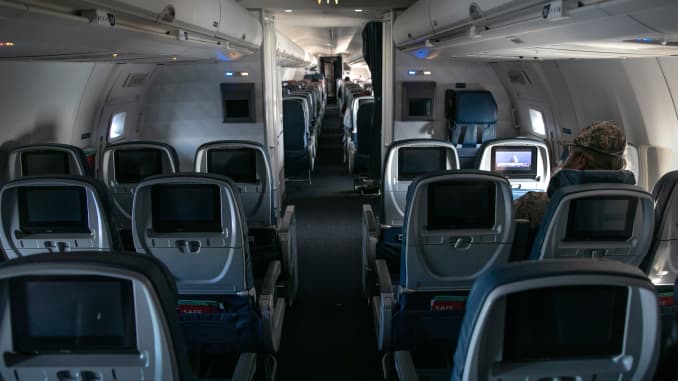By Quint Forgey
Few Americans trust President Donald Trump when it comes to the coronavirus pandemic, according to a new survey, and less than half of respondents believe the federal government is taking sufficient steps to combat the public health crisis.


© Win McNamee/Getty Images President Donald Trump.
An NPR/PBS NewsHour/Marist poll released Tuesday shows that only 37 percent of those polled have either “a good amount” or “a great deal” of trust in the information they hear from the president about the coronavirus, while 60 percent say they do “not very much” or “not at all” trust Trump’s words on the subject.
The president’s trust ratings regarding the coronavirus rank lower among those surveyed than other prominent sources of information, including the news media, state and local governments, and public health experts. More Americans than not disapprove of the way he is handling the pandemic, by a margin of 49-44 percent, and his overall job approval rating rests at 43 percent.
The poll’s results come after the White House spent weeks downplaying the coronavirus’ threat to the United States, even as public health officials within the administration sounded alarms over its risk to the country and warned of its rapid rates of transmission.
Only recently has Trump adopted a more somber tone when discussing the crisis, acknowledging Tuesday that “this is a very bad one” and cautioning Americans that “we have an invisible enemy” in the coronavirus.






Slides 49: Residents step on measured tape placed outside a supermarket to practice social distancing as a precautionary measure against the spread of the new coronavirus in Manila, Philippines, early Tuesday, March 17, 2020. For most people, the new coronavirus causes only mild or moderate symptoms. For some, it can cause more severe illness, especially in older adults and people with existing health problems.
An NPR/PBS NewsHour/Marist poll released Tuesday shows that only 37 percent of those polled have either “a good amount” or “a great deal” of trust in the information they hear from the president about the coronavirus, while 60 percent say they do “not very much” or “not at all” trust Trump’s words on the subject.
The president’s trust ratings regarding the coronavirus rank lower among those surveyed than other prominent sources of information, including the news media, state and local governments, and public health experts. More Americans than not disapprove of the way he is handling the pandemic, by a margin of 49-44 percent, and his overall job approval rating rests at 43 percent.
The poll’s results come after the White House spent weeks downplaying the coronavirus’ threat to the United States, even as public health officials within the administration sounded alarms over its risk to the country and warned of its rapid rates of transmission.
Only recently has Trump adopted a more somber tone when discussing the crisis, acknowledging Tuesday that “this is a very bad one” and cautioning Americans that “we have an invisible enemy” in the coronavirus.






Slides 49: Residents step on measured tape placed outside a supermarket to practice social distancing as a precautionary measure against the spread of the new coronavirus in Manila, Philippines, early Tuesday, March 17, 2020. For most people, the new coronavirus causes only mild or moderate symptoms. For some, it can cause more severe illness, especially in older adults and people with existing health problems.
© Aaron Favila/AP Photo
The world is battling an outbreak of a new coronavirus called COVID-19, which started in the city of Wuhan, China, and has been spreading since. The virus has claimed more than 5,000 lives and infected more than 100,000 people around the world. The World Health Organization declared a global pandemic on March 11.
(Pictured) Residents step on measured tape placed outside a supermarket to practice social distancing as a precautionary measure against the spread of the new coronavirus in Manila, Philippines on March 17.
Slideshow by photo services
The more dire rhetoric from the president was accompanied by a new series of increasingly stern guidelines from the administration, which recommended avoiding group gatherings of more than 10 people, working or attending school from home whenever possible, and abstaining from eating or drinking at bars, restaurants and food courts.
It remains to be seen whether the latest measures will bolster public confidence in the administration’s ability to fight the coronavirus. Just 46 percent of Americans believe the federal government is doing enough to prevent the disease’s spread, down from 61 percent in February.
The NPR/PBS NewsHour/Marist poll was conducted March 13-14, surveying 835 adults. The margin of sampling error is plus or minus 4.8 percentage points.
The world is battling an outbreak of a new coronavirus called COVID-19, which started in the city of Wuhan, China, and has been spreading since. The virus has claimed more than 5,000 lives and infected more than 100,000 people around the world. The World Health Organization declared a global pandemic on March 11.
(Pictured) Residents step on measured tape placed outside a supermarket to practice social distancing as a precautionary measure against the spread of the new coronavirus in Manila, Philippines on March 17.
Slideshow by photo services
The more dire rhetoric from the president was accompanied by a new series of increasingly stern guidelines from the administration, which recommended avoiding group gatherings of more than 10 people, working or attending school from home whenever possible, and abstaining from eating or drinking at bars, restaurants and food courts.
It remains to be seen whether the latest measures will bolster public confidence in the administration’s ability to fight the coronavirus. Just 46 percent of Americans believe the federal government is doing enough to prevent the disease’s spread, down from 61 percent in February.
The NPR/PBS NewsHour/Marist poll was conducted March 13-14, surveying 835 adults. The margin of sampling error is plus or minus 4.8 percentage points.











